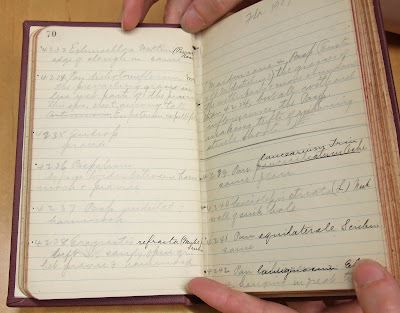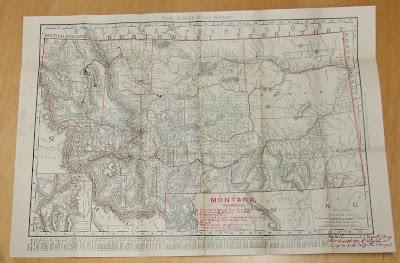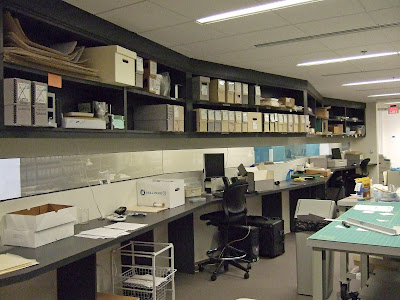Introduction
As I mentioned in the previous post, I met Carolyn Sheffield at a MARAC conference and wanted to know all about her job as Project Manager of the Smithsonian Institution’s Field Book Project. She invited me to visit her in D.C., and was very generous with her time, sharing many interesting stories about the field books and her work at the National Museum of Natural History. Below I have included some of the footage I shot of Carolyn explaining the importance of the project, especially when it comes to natural history and botanical research. Accompanying the videos are some close-up photos of the materials she featured in the clips. It was enormously fun to shoot those pieces with Carolyn, and as you’ll see she’s a natural in front of the camera.
About the Field Book Project
Although the project itself only began in June 2010, nearly 2,500 of the estimated 6,000 field books at the Smithsonian have already been cataloged. The bulk of these materials range from the mid-1800s to the late 1900s. It started as a collaboration between the Smithsonian Institution Archives and the National Museum of Natural History (another arm of the Smithsonian) with the goal of improving access to biodiversity field books. Researchers use these primary source materials to see how biologists documented their discoveries of plants, animals, and cultures in the field.
According to Carolyn, “These materials share a lot of characteristics with archival collections in that they are very much a record of that field work. They also remain an integral part of the specimen collections in the museum because of all the rich supplemental information they provide.” Because the notes (as you’ll see below) are frequently handwritten and later bound when the scientists return from their work, they resemble library items. “What we find is that field books have been managed in each of these contexts—archives, museums, and libraries—and there is a real need for establishing best practices,” she continues.
So, in the future, if a researcher wants to view all of the work done by a certain biologist while he/she worked for different government agencies, the Field Book Project will prevent the researcher from having to visit the Department of Botany, the Archives, and/or a repository outside the Smithsonian to access all that information. In fact, one of the long term goals for the Field Book Registry once it becomes available online, is to link to digitized samples within the Herbarium and other repositories. It’s pretty exciting when you think about how much more connected a huge chunk of biological research will become when the project is completed. In the meantime, though, you can keep track of the great work on the project blog at http://www.mnh.si.edu/rc/fieldbooks/.
This next bit is for the archivists who read this blog. In it, Carolyn does a very good job of explaining the technical aspects of her approach to description and why the methods are important to the end user.
Our approach is to bridge the collection-level description of archives with the item-level description of libraries and to enrich that with authority records for persons, organizations, and exhibitions. We use Natural Collections Description (NCD), which is a natural history metadata schema, for the collection-level access. NCD is a rich schema that lies between Dublin Core and Encoded Archival Description in its breadth. We then use the Metadata Object Description Schema (MODS) for the item-level description. MODS is a Library of Congress standard that includes a subset of MARC tags made available as language-based xml elements. We tie the two together with Encoded Archival Context (EAC) records for describing the persons, organizations, and expeditions involved in the creation of the collections and items. This will be especially important as one of the longer term goals for the project is to extend the Field Book Registry to accept content contributed by repositories beyond the Smithsonian and having those persons, organizations, and expeditions entered and described consistently will help end users find all the relevant materials, regardless of how many institutions physically hold field books from a given collector or expedition.
Here’s a short video of Carolyn explaining the basics of the project, how it is funded, and what its goals are (including preservation efforts).
The materials covered in the project include the disciplines of botany, entomology, vertebrate and invertebrate zoology, and paleobiology. In order to cover such a wide array of fields, the Smithsonian partners with a distinguished group of institutions to share collections and work including the Biodiversity Heritage Library, Botany Libraries and Archives at Harvard University, California Academy of Sciences, Ernst Mayr Library of the Museum of Comparative Zoology at Harvard University, LuEsther T. Mertz Library at New York Botanical Garden, and Missouri Botanical Garden. Carolyn says, “We also are involved in the Connecting Content project led by the California Academy of Sciences. Connecting Content examines the relationships between field book content, the specimens, and published taxonomic literature.”
Sample Field Books
To begin our sampling of the field books, Carolyn (in the short video below) shows us some of the library-bound journals of Mary Agnes Chase (although in the book shown below, she wrote as “Agnes Chase”), 1869-1963. According to the Smithsonian,
The foremost grass specialist of her time ended her formal education after grammar school. She began collecting and illustrating plants in her twenties, and was hired by Chicago's Field Museum in 1901 and later as a botanical illustrator for the U.S. Department of Agriculture. Scientific illustration was a way for women to enter science at the turn of the century. Chase studied on her own at the U.S. National Herbarium, and in 1906 published her first scientific paper and secured her first professional position, with Albert S. Hitchcock at the USDA. ... After The North American Species of Panicum, by Chase and Hitchcock was published in 1910, Chase published Tropical North American Species of Panicum in 1915, and Grasses of the West Indies in 1917. Chase was actively involved in the women's suffrage movement and aligned herself with the radical Woman's Party. She was jailed several times for participating in suffrage demonstrations, and continued her radical activity despite threats of dismissal from the USDA. Throughout her career, she demonstrated a special concern for the careers of young women botanists, and maintained a correspondence and specimen exchange network, providing training for young women entering the field as well. ... The First Book of Grasses, the Structure of Grasses Explained for Beginners was published in 1922. ... Chase retired from the USDA in 1939, at the age of seventy, but continued to work five or six days a week on her collections in the Smithsonian's tower.
Here is a close-up of the field book in Carolyn’s hands:
 |
| From Smithsonian Tours |
Next, Carolyn shows us a field notebook from Edgar Mearns (1856-1916), an army surgeon and field naturalist. Among his many accomplishments, from 1892 to 1894, he explored the El Paso, Texas to San Clemente Island boundary, and collected 30,000 specimens of flora and fauna which were deposited in the United States National Museum (USNM). This notebook has particular significance because it originated during the Smithsonian’s African Expedition led by Theodore Roosevelt from 1909-1910.
Below is a close-up of one of Mearns’ pasted-in notes.
 |
| From Smithsonian Tours |
As was the case with Mary Agnes Chase, David Griffiths (1867-1935) and Emil F. Lange were researchers who worked for the U.S.D.A. The Smithsonian says, “Griffiths was an authority on cacti, especially the genus Opuntia. His collection of cacti was donated to the United States National Museum in 1935.” The field book Carolyn shows us from 1900 isn’t just important because it describes forage and irrigation soil samples. She explains why in the short video below.
Here is a close up of the photos from the field book shown in the video.
 |
| From Smithsonian Tours |
And, because you know I love maps, I’m also including a close-up below of a map that Griffiths and Lange annotated that was folded up and enclosed in the back pocket of the field notebook.
 |
| From Smithsonian Tours |
If you are interested in seeing more close-ups of the map, visit my Picasa site (https://picasaweb.google.com/debra.schiff/SmithsonianTours#5669352078790276674).
In the last short video below, Carolyn shares with us an excerpt of field notes by Joseph Francis Rock (1884-1962), a noted botanist who specialized in the flora of Hawaii and China. After moving from Austria to Honolulu, Hawai’i in 1907, he became the state’s first official botanist. He also explored several locations in Southeast Asia, and directed many expeditions during which he collected zoological, ornithological, and botanical specimens. The field notes in Carolyn’s hands are from his journal on Siam, Burma, and Assam in 1920-1921.
Here is a close-up of the excerpt she read:
 |
| From Smithsonian Tours |
Here is a photo of the map Rock created of his travels:
 |
| From Smithsonian Tours |
About the Project Manager
Carolyn holds a Master’s of Library Science with a specialization in Archives, Records, and Information Management from the iSchool at the University of Maryland. She became interested in the field because, as she says, she was fascinated with “the stuff.” It later grew into an obsession “with the intersections of information needs and ways of describing the stuff. Add to that the sliding scale of ever-growing online content delivery methods and evolving user expectations, and it’s a stimulating intellectual exercise that you could happily devote a lifetime to (at least I could),” she explains.
Her favorite parts of the work include the collaborative aspects, the access challenges, and the rewards of bringing still-relevant resources to very grateful scientific researchers. For students or recent graduates, her very sound advice should be considered, “Figure out what aspect of the field you are most interested in and work towards getting as much experience in that area as early as possible, whether that means volunteering or interning. Also, don’t be afraid to ask questions! We’re a profession of people who love to help people find the answers that they need. Participating in professional organizations and signing up on list servs is a great way to connect with a lot of librarians and archivists who are happy to answer your questions as you get started in the field.”
Contact Information
Carolyn Sheffield
Project Manager, Field Book Project
Smithsonian Institution
National Museum of Natural History
Department of Botany
MRC 166 PO Box 37012
Washington, DC 20013-7012
(202) 633-0902
sheffieldc@si.edu











